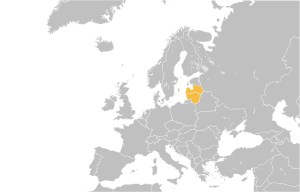
Back Balte Afrikaans شعوب البلطيق Arabic Baltlar Azerbaijani بالتلار AZB Baltā BAT-SMG Балты Byelorussian Балты BE-X-OLD Балти Bulgarian Bàltics Catalan Балташ CE
This article has multiple issues. Please help improve it or discuss these issues on the talk page. (Learn how and when to remove these messages)
|
 Countries with a predominantly Baltic population | |
| Total population | |
|---|---|
| 6.5–7.0 million (including the diaspora)[1][2] | |
| Regions with significant populations | |
| 2,397,418[3] | |
| 1,175,902[4] | |
| Languages | |
| Baltic languages | |
| Religion | |
| Predominantly Roman Catholicism and Protestantism; minority Eastern Orthodoxy and Baltic neopaganism | |
| Related ethnic groups | |
| Slavs | |
| Part of a series on |
| Indo-European topics |
|---|
 |
The Balts or Baltic peoples (Lithuanian: baltai, Latvian: balti) are a group of peoples inhabiting the eastern coast of the Baltic Sea who speak Baltic languages. Among the Baltic peoples are modern-day Lithuanians (including Samogitians) and Latvians (including Latgalians) — all East Balts — as well as the Old Prussians, Curonians, Sudovians, Skalvians, Yotvingians and Galindians — the West Balts — whose languages and cultures are now extinct, but made a large influence on the living branches, especially on literary Lithuanian language.
The Balts are descended from a group of Proto-Indo-European tribes who settled the area between the lower Vistula and southeast shore of the Baltic Sea and upper Daugava and Dnieper rivers, and which over time became differentiated into West and East Balts. In the fifth century CE, parts of the eastern Baltic coast began to be settled by the ancestors of the Western Balts, whereas the East Balts lived in modern-day Belarus, Ukraine and Russia. In the first millennium CE, large migrations of the Balts occurred. By the 13th and 14th centuries, the East Balts shrank to the general area that the present-day Balts and Belarusians inhabit.
Baltic languages belong to the Balto-Slavic branch of the Indo-European languages. One of the features of Baltic languages is the number of conservative or archaic features retained.[5][better source needed]
- ^ "Lietuviai Pasaulyje" (PDF), osp.stat.gov.lt
- ^ Latvian at Ethnologue (18th ed., 2015) (subscription required)
- ^ "Rodiklių duomenų bazė - Oficialiosios statistikos portalas". osp.stat.gov.lt.
- ^ "Iedzīvotāji pēc tautības gada sākumā 1935 - 2023". data.stat.gov.lv.
- ^ Bojtár page 18.